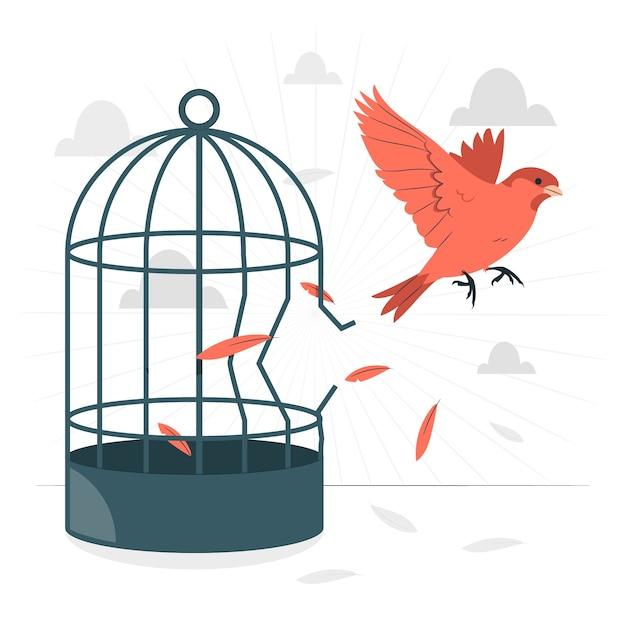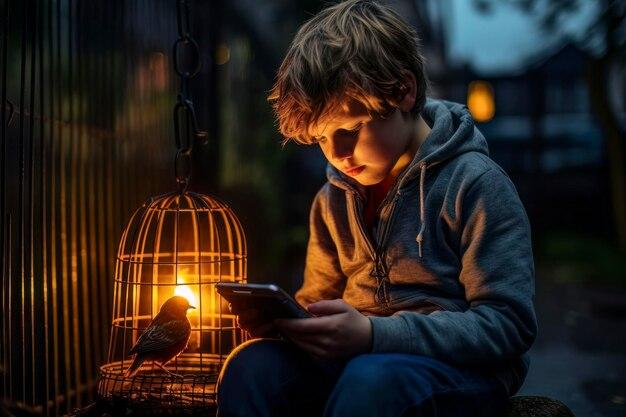Imagine a bird trapped inside a cage, its wings fluttering against the cold metal bars, longing for freedom. This vivid image is found in the powerful poem, “Caged Bird,” written by Maya Angelou. Published in 1983, this iconic piece of literature continues to resonate with readers, captivating their hearts and minds.
In this blog post, we will delve into the profound symbolism behind the caged bird. We will explore the poem’s rhyme scheme and the type of poem it represents. Additionally, we will analyze the speaker’s perspective and the central idea conveyed. Furthermore, we will discuss the role of imagery in Maya Angelou’s writing and the mood that the poem evokes.
Join us on this enlightening journey as we uncover the hidden meanings within the lines of “Caged Bird” and gain a deeper understanding of the human spirit’s desire for liberation.
What Does the Caged Bird Symbolize
In the realm of literary symbolism, few images evoke more emotional depth and metaphorical significance than that of a caged bird. The concept of a bird confined within the boundaries of a cage, unable to soar freely in the open sky, has long captivated the human imagination. But what does this powerful symbol truly represent? Let’s explore the rich meaning behind the caged bird metaphor and its cultural implications in American literature.
A Captive Spirit: The Loss of Freedom
At its core, the caged bird serves as a powerful representation of the loss of freedom and the yearning for liberation. Just as the bird’s wings are clipped, preventing it from taking flight, so too are individuals stifled by personal, societal, or systemic constraints. This metaphorical image resonates deeply with the aspirations of marginalized communities throughout history, especially within the social and political landscape of the United States.
The African American Experience: Struggles and Resilience
Within the context of American literature, the caged bird symbol takes on an even more poignant significance when exploring the African American experience. Authors such as Maya Angelou, in her renowned memoir “I Know Why the Caged Bird Sings,” utilize the metaphor to depict the struggles, resilience, and ultimate quest for equality and freedom within a racially oppressive society.
Voices of Resistance: Breaking the Cage
While the caged bird may represent confinement and oppression, it also serves as a catalyst for change and resistance. Just as a bird’s song can pierce through the metal bars of its cage, so too can the voices of the oppressed transcend the boundaries imposed upon them. Throughout history, individuals and communities have utilized their voices as a tool of empowerment and liberation, pushing against the confines of injustice and discrimination.
Hope and Transformation: Wings Unfurled
Despite the confinement, the caged bird symbolizes an enduring sense of hope and the potential for transformation. It reminds us that no cage, however impenetrable, can fully suppress the human spirit. From the lyrics of spirituals sung by enslaved African Americans to the poems of the Harlem Renaissance, the theme of liberation and the yearning for freedom remain central, serving as a testament to the indomitable nature of the human soul.
An Unforgettable Metaphor: The Symbolic Power
In conclusion, the caged bird stands as a potent symbol in American literature, representing the loss of freedom, the struggles and resilience of marginalized communities, the power of resistance, and the enduring hope for transformation. Through the metaphor of the caged bird, authors have captured the complexities of the human condition and the universal quest for liberty. It is a symbol that continues to resonate deeply with readers, serving as a reminder of the beauty, strength, and inherent desire for freedom that resides within us all.
So the next time you come across the image of a caged bird in a piece of literature or art, take a moment to reflect on its profound symbolism and the myriad of emotions and ideas it encapsulates. Open your mind to the messages it conveys, and allow its wings of meaning to carry you to new heights of understanding.
Now, let us set our own spirits free and soar beyond the constraints of the written word, for the cage of this blog post can never truly hold our imaginations captive. Happy exploring!
FAQ: What Does the Caged Bird Symbolize
In Maya Angelou’s iconic poem “Caged Bird,” the imagery and symbolism are deeply intertwined to convey powerful messages about freedom, oppression, and the indomitable spirit of the human soul. This FAQ-style subsection aims to answer some common questions about the poem and shed light on its meaning, rhyme scheme, speaker, and more.
What drives all the joy away in the poem the school boy
In the poem “The School Boy,” not “Caged Bird,” joy is threatened by the rigid structure and strict discipline of the educational system. The speaker suggests that excessive formal education stifles a child’s natural sense of wonder and imagination, replacing it with “funeral gloom” and robbing them of their innocence.
What is the rhyme scheme of the caged bird
The rhyme scheme of “Caged Bird” is a combination of irregular and occasional internal rhymes. While the poem does not strictly adhere to a specific pattern, it predominantly follows an ABCB rhyme scheme. This irregularity adds to the poem’s musicality and reflects the unpredictable nature of life and freedom.
Who is the speaker in the poem “The Last Bargain”
In “The Last Bargain,” again not “Caged Bird,” the speaker is an individual contemplating their last bargain with life itself. It is a monologue, and the speaker’s identity remains anonymous. This anonymity allows the reader to relate to the speaker’s bargaining with life’s hardships and searching for small victories.
What type of poem is “Caged Bird”
“Caged Bird” is a lyrical poem that combines elements of free verse and metaphorical storytelling. This type of poem allows the author to express emotions and ideas more freely by breaking away from the constraints of traditional verse forms.
Why can’t the summer arise in joy
In “Caged Bird,” the phrase “summer’s ardent breath” implies a season of freedom, happiness, and growth. However, the caged bird cannot experience joy because it is confined and deprived of opportunities to fully embrace life. The poem draws a stark contrast between the free bird’s ability to revel in the joys of nature and the caged bird’s restricted existence.
What does the caged bird symbolize
The caged bird in Maya Angelou’s poem symbolizes various forms of oppression and the longing for freedom. It represents marginalized individuals who are constrained by societal norms, racial prejudice, or personal circumstances. Through the bird’s struggle for liberation, the poem explores themes of resilience, hope, and the constant pursuit of freedom.
How does Maya Angelou use imagery
Maya Angelou masterfully employs vivid imagery throughout “Caged Bird” to evoke powerful emotions and convey her intended messages. By describing the sky, the tree, and the wind, she paints a contrast between the unbounded freedom of the natural world and the limitations imposed on the caged bird. This imagery creates a sensory experience for the reader, enhancing the poem’s impact.
What happens when the bird is made to sit in the cage, according to the speaker
In “Caged Bird,” the speaker suggests that when the bird is made to sit in a cage, its wings become clipped and its song silenced. The act of confining the bird represents the suppression of one’s voice, dreams, and aspirations through oppression, discrimination, or imprisonment.
What is the speaker’s last bargain, and why does he call it the best
In “The Last Bargain,” the speaker’s last bargain refers to a compromise they make with life. The speaker considers it the best because it reflects their ability to find contentment and make peace with the imperfect world around them. It signifies a surrender to life’s realities and a recognition that the pursuit of absolute fulfillment might be unattainable.
What is ironic about the caged bird
The irony in “Caged Bird” lies in the stark contrast between the free bird’s soaring existence and the caged bird’s confined reality. While the caged bird’s wings are physically clipped, its spirit remains resilient and unbroken. This irony highlights the enduring power of the human spirit to find hope and seek liberation even in the face of adversity.
What is the central idea of the poem “Caged Bird”
The central idea of “Caged Bird” is the universal yearning for freedom and the inherent value of self-expression. The poem serves as a powerful metaphor for the injustice and oppression faced by marginalized individuals. It calls attention to the resilience of the human spirit and advocates for the relentless pursuit of freedom and equality.
Why does the boy compare himself to a caged bird
Apologies, but “Caged Bird” does not involve a boy. It is a different poem by Maya Angelou. Please refer to the appropriate poem for the boy comparison.
Who is being compared to a caged bird
In “Caged Bird,” the caged bird is a metaphor for individuals who face various forms of oppression, discrimination, or confinement. While the poem does not explicitly mention a specific person, it symbolizes the collective struggle of those who long for freedom and equality.
How does the caged bird behave
The caged bird’s behavior reflects its yearning for freedom. Although confined, it fights against its limitations with a persistent spirit. The caged bird sings of its longing for freedom, using its voice as a form of defiance and resistance against the harsh reality of its captivity.
Why was the “Caged Bird” poem written
“Caged Bird” was written by Maya Angelou as an exploration of the human quest for freedom and the resilience of the human spirit against oppression. Inspired by her own experiences with racism and discrimination, Angelou sought to shed light on the struggle for equality and ignite the reader’s empathy and understanding.
What is the mood of “Caged Bird”
The mood of “Caged Bird” fluctuates between hope and despair. While the poem deals with themes of oppression and confinement, it also expresses a resilient spirit and a relentless pursuit of freedom. The contrasting emotions evoke a sense of tension, prompting the reader to reflect upon the complexities of the human condition.
Maya Angelou’s “Caged Bird” remains a timeless masterpiece that resonates with readers around the world. Through its powerful imagery and symbolism, the poem exposes the injustice of oppression while celebrating the indomitable spirit of the human soul. Remember, like the caged bird, we too can overcome our limitations and soar towards a brighter future.

